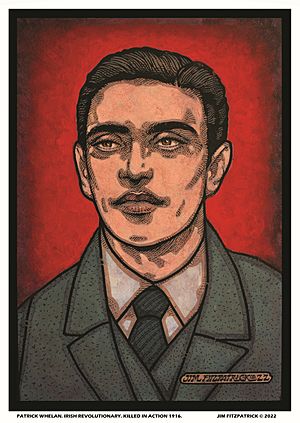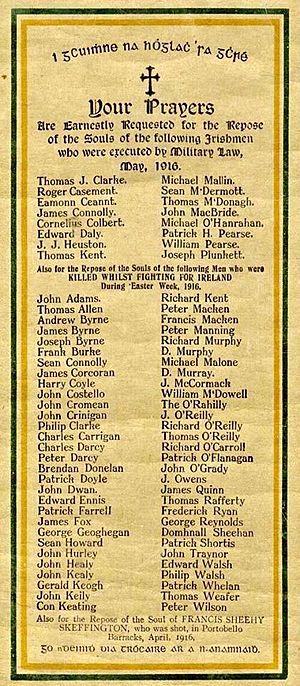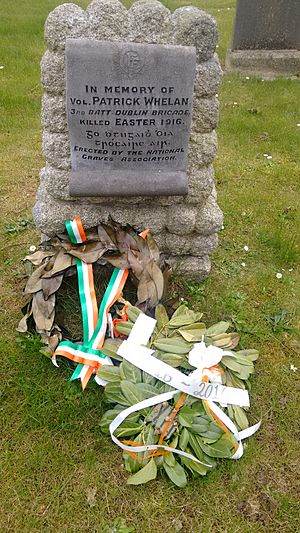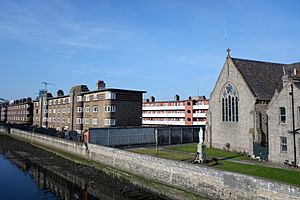Patrick Whelan facts for kids
Quick facts for kids
Patrick Whelan
|
|
|---|---|

A portrait of Whelan by Jim Fitzpatrick
|
|
| Born | 4 September 1893 69 Thorncastle Street Ringsend, Dublin
|
| Died | 26 April 1916 (aged 22) Boland's Mill, Dublin
|
| Nationality | Irish |
| Other names | Paddy Whelan |
| Occupation | Ship's Carpenter |
| Known for | Irish Volunteer killed in action in Boland's Mill during the Easter Rising of 1916. Whelan House, Thorncastle Street, Ringsend, Dublin is named in his honour. |
Patrick Whelan (born September 4, 1893 – died April 26, 1916) was a brave Irish Volunteer. He was killed during a major event called the Easter Rising in 1916. This happened at Boland's Mill during the Battle of Mount Street Bridge. Patrick was only 22 years old when he died. Years later, in 1941, he was given the 1916 Medal to honor his sacrifice. A building in Dublin, Whelan House, is named after him. It is located on Thorncastle Street in Ringsend, where he was born.
Contents
Who Was Patrick Whelan?
Patrick's Early Life
Patrick Whelan was born on September 4, 1893. His father, John Whelan, was a fisherman, and his mother was Mary Jane Mullen. They lived at 69 Thorncastle Street in Ringsend, Dublin.
Around the late 1800s, many people in Ireland became very interested in their Irish culture. This led to a movement called the Gaelic revival. Patrick was an active member of the Ringsend Gaelic League, which promoted Irish language and sports. He was also a famous hurler, playing for the Fontenoy's Club in Irishtown.
Like many people in Ringsend, Patrick worked on ships. He was a ship's carpenter. He also joined the Irish Volunteers, a group that fought for Ireland's freedom.
Preparing for the Rising
Before the Easter Rising began, Patrick was sent on a mission. He traveled to Tralee in County Kerry. He returned with sad news about Roger Casement being captured. Casement was an important figure who tried to get help for Ireland from Germany.
The Easter Rising: A Week of Fighting
Patrick Whelan was part of the 3rd Battalion, "D" Company, in the Dublin Brigade. He fought under Commandant Éamon de Valera. The 3rd Battalion's main base was at Boland's Bakery. This location was very important because it controlled the railway line and the main road into Dublin. This road came from Dún Laoghaire (which was called Kingstown back then).
The 3rd Battalion was supposed to cover a large area of South Dublin. However, fewer men showed up than expected. This was because Eoin MacNeill had issued orders telling Volunteers not to take part in the Rising. MacNeill had learned about Roger Casement's arrest and the loss of German weapons. He tried to stop the Rising at the last minute, causing a lot of confusion.
Despite the confusion, the British army thought that de Valera's forces were "the best trained and best led among the rebels."
Fighting at Boland's Mill
Patrick Whelan was one of 14 Volunteers from "D" Company who took over Boland's Mill. They arrived around noon on Easter Monday.
Lieutenant Joseph O'Byrne, who was in charge of the unit, described the first attack:
Tuesday evening at around 6 o'clock we first received attention from the enemy. Two 18-pounder 3 inch shells ripped through the wall of the top loft where the most of my men were stationed, scattering lumps of metal and jagged stones around .... The shells had burst several sacks of flour and bran and the loft was smothered in a fog of flour for quite ten minutes.
—Lieutenant Joseph O'Byrne, Acting Captain of the Unit
This was the first time artillery was used that week. A gunboat called the "Helga" (now known as the Irish patrol vessel Muirchú) fired shells from the river Liffey. Since only the top floor of the mill was in the gunboat's view, Captain O'Byrne moved his men to the third floor. It was safer there, and they could still see well.
The Battle of Mount Street Bridge
The next day, Wednesday, April 26, British soldiers arrived from England. They were from the Sherwood Foresters Regiment and marched into the city. Major-General William Lowe ordered them to take Mount Street Bridge "at all costs."
The fighting that followed at Mount Street Bridge was very intense. Even though the Volunteers were greatly outnumbered, two-thirds of all British casualties that week happened there. The main fighting took place at 25 Northumberland Road and Clanwilliam House. But other parts of the 3rd Battalion, like Boland's Mill, also played a role.
A witness named Jack O'Shea said that "during the battle for Mount Street bridge, fire came towards the mill." Even though they were under constant sniper fire, the Volunteers at Boland's Mill fired back. Their shots kept the British soldiers in nearby Beggars Bush Barracks pinned down. The Battle of Mount Street Bridge was the most successful military action for the Irish during the Rising.
Patrick's Death and Burial
As the battle continued, Captain O'Byrne received new orders. He was told to direct heavy fire towards Baggot Street Bridge. A group of British soldiers was trying to get around the 3rd Battalion's position from that direction. The Volunteers at Boland's Mill fired a lot of shots, forcing the British to retreat.
However, during this exchange, Patrick Whelan was tragically shot in the head. This happened around 4 PM on Wednesday, April 26. Captain O'Byrne said Patrick "expired in about a minute." The fighting at the Mill was so heavy that Patrick's body lay where he fell for over 30 hours.
On Friday morning, Captain O'Byrne's brother Peter and Volunteer Willie Bruen made a temporary coffin. They buried Patrick's body under a pile of clinkers (a type of ash) in the building's yard. Even though the yard was somewhat protected, bullets were still hitting the walls and windows. Captain O'Byrne read some prayers, and they all said the Rosary.
The fighting at Boland's Mill continued until the Irish Volunteers surrendered on Sunday, April 30, 1916.
Patrick Whelan's body was later buried in Glasnevin Cemetery on May 3. A special memorial stone was put up for him by The National Graves Association. It was unveiled on November 24, 1935, after talking with Patrick's family.
Whelan House: A Lasting Tribute
Whelan House was built in 1936 on Thorncastle Street in Ringsend. This is the same street where Patrick Whelan was born. The building was named in his honor. It stands next to O'Rahilly House, which was built at the same time to honor The O'Rahilly, another important figure in the Rising.
Next to Whelan House is St. Patrick's Church in Ringsend. A statue of Our Lady overlooks the canal there. This statue was given by Patrick's younger brother, Thomas A. Whelan. Thomas started the Ringsend branch of the Catholic Young Men's Society (CYMS). The statue is a memorial to both Patrick and their older brother, Martin Whelan. Martin was also killed in action just five weeks after Patrick. He died during the Battle of Jutland when German gunfire sank HMS Defence.
Images for kids





